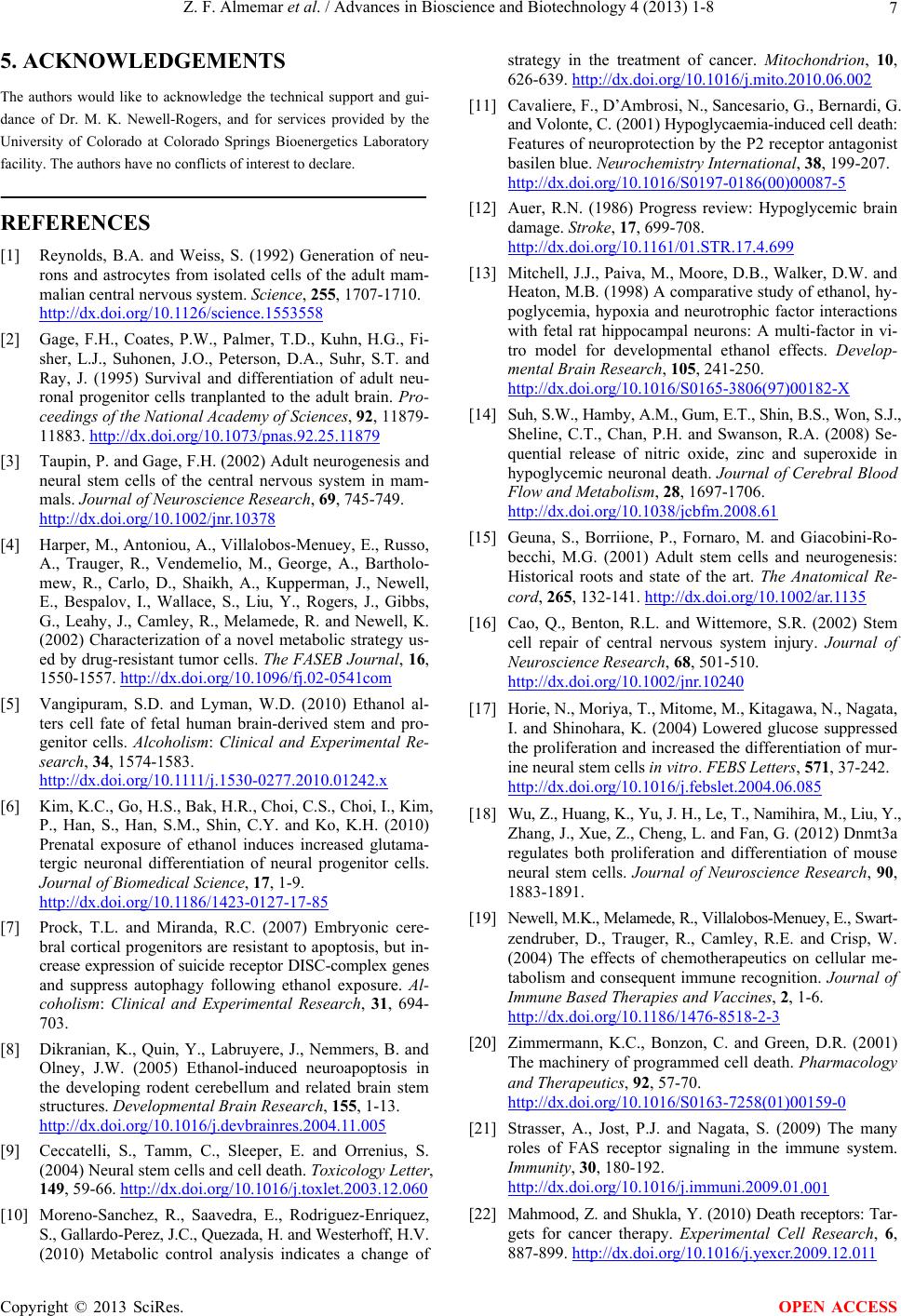
Z. F. Almema r et al. / Advances in Bioscience and Biotechnology 4 (2013) 1-8 7
5. ACKNOWLEDGEMENTS
The authors would like to acknowledge the technical support and gui-
dance of Dr. M. K. Newell-Rogers, and for services provided by the
University of Colorado at Colorado Springs Bioenergetics Laboratory
facility. The authors have no conflicts of interest to declare.
REFERENCES
[1] Reynolds, B.A. and Weiss, S. (1992) Generation of neu-
rons and astrocytes from isolated cells of the adult mam-
malian central nervous system. Science, 255, 1707-1710.
http://dx.doi.org/10.1126/science.1553558
[2] Gage, F.H., Coates, P.W., Palmer, T.D., Kuhn, H.G., Fi-
sher, L.J., Suhonen, J.O., Peterson, D.A., Suhr, S.T. and
Ray, J. (1995) Survival and differentiation of adult neu-
ronal progenitor cells tranplanted to the adult brain. Pro-
ceedings of the National Academy of Sciences, 92, 11879-
11883. http://dx.doi.org/10.1073/pnas.92.25.11879
[3] Taupin, P. and Gage, F.H. (2002) Adult neurogenesis and
neural stem cells of the central nervous system in mam-
mals. Journal of Neuroscience Research, 69, 745-749.
http://dx.doi.org/10.1002/jnr.10378
[4] Harper, M., Antoniou, A., Villalobos-Menuey, E., Russo,
A., Trauger, R., Vendemelio, M., George, A., Bartholo-
mew, R., Carlo, D., Shaikh, A., Kupperman, J., Newell,
E., Bespalov, I., Wallace, S., Liu, Y., Rogers, J., Gibbs,
G., Leahy, J., Camley, R., Melamede, R. and Newell, K.
(2002) Characterization of a novel metabolic strategy us-
ed by drug-resistant tumor cells. The FASEB Journal, 16,
1550-1557. http://dx.doi.org/10.1096/fj.02-0541com
[5] Vangipuram, S.D. and Lyman, W.D. (2010) Ethanol al-
ters cell fate of fetal human brain-derived stem and pro-
genitor cells. Alcoholism: Clinical and Experimental Re-
search, 34, 1574-1583.
http: //dx .do i.org/10.1111/j.1530-0277.2010.01242.x
[6] Kim, K.C., Go, H.S., Bak, H.R., Choi, C.S., Choi, I., Kim,
P., Han, S., Han, S.M., Shin, C.Y. and Ko, K.H. (2010)
Prenatal exposure of ethanol induces increased glutama-
tergic neuronal differentiation of neural progenitor cells.
Journal of Biomedical Science, 17, 1-9.
http://dx.doi.org/10.1186/1423-0127-17-85
[7] Prock, T.L. and Miranda, R.C. (2007) Embryonic cere-
bral cortical progenitors are resistant to apoptosis, but in-
crease expression of suicide receptor DISC-complex genes
and suppress autophagy following ethanol exposure. Al-
coholism: Clinical and Experimental Research, 31, 694-
703.
[8] Dikranian, K., Quin, Y., Labruyere, J., Nemmers, B. and
Olney, J.W. (2005) Ethanol-induced neuroapoptosis in
the developing rodent cerebellum and related brain stem
structures. Developmental Brain Research, 155, 1-13.
http://dx.doi.org/10.1016/j.devbrainres.2004.11.005
[9] Ceccatelli, S., Tamm, C., Sleeper, E. and Orrenius, S.
(2004) Neural stem cells and cell death. Toxicology Letter,
149, 59-66. http://dx.doi.org/10.1016/j.toxlet.2003.12.060
[10] Moreno-Sanchez, R., Saavedra, E., Rodriguez-Enriquez,
S., Gallardo-Perez, J.C., Quezada, H. and Westerhoff, H.V.
(2010) Metabolic control analysis indicates a change of
strategy in the treatment of cancer. Mitochondrion, 10,
626-639. http://dx.doi.org/10.1016/j.mito.2010.06.002
[11] Cavaliere, F., D’Ambrosi , N., Sanc esar io, G., Berna rdi, G.
and Volonte, C. (2001) Hy poglycaemia-induced c ell death:
Features of neuroprotection by the P2 receptor antagonist
basilen blue. Neurochemistry International, 38, 199-207.
http://dx.doi.org/10.1016/S0197-0186(00)00087-5
[12] Auer, R.N. (1986) Progress review: Hypoglycemic brain
damage. Stroke, 17, 699-708.
http://dx.doi.org/10.1161/01.STR.17.4.699
[13] Mitchell, J.J., Paiva, M. , Moore, D.B., Walker, D.W. and
Heaton, M.B. (1998) A comparative study of ethanol, hy-
poglycemia, hypoxia and neurotrophic factor interactions
with fetal rat hippocampal neurons: A multi-factor in vi-
tro model for developmental ethanol effects. Develop-
mental Brain Research, 105, 241-250.
http://dx.doi.org/10.1016/S0165-3806(97)00182-X
[14] Suh, S.W., Hamby, A.M., Gum, E.T., Shin, B.S., Won, S.J.,
Sheline, C.T., Chan, P.H. and Swanson, R.A. (2008) Se-
quential release of nitric oxide, zinc and superoxide in
hypoglycemic neuronal death. Journal of Cerebral Blood
Flow and Metabolism, 28, 1697-1706.
http://dx.doi.org/10.1038/jcbfm.2008.61
[15] Geuna, S., Borriione, P., Fornaro, M. and Giacobini-Ro-
becchi, M.G. (2001) Adult stem cells and neurogenesis:
Historical roots and state of the art. The Anatomical Re-
cord, 265, 132-141. http://dx.doi.org/10.1002/ar.1135
[16] Cao, Q., Benton, R.L. and Wittemore, S.R. (2002) Stem
cell repair of central nervous system injury. Journal of
Neuroscience Research, 68, 501-510.
http://dx.doi.org/10.1002/jnr.10240
[17] Horie, N., Moriya, T., Mitome, M., Kitagawa, N., Nagata,
I. and Shinohara, K. (2004) Lowered glucose suppressed
the proliferation and increased the differentiation of mur-
ine neural stem cells in vitro. FEBS Letters, 571, 37-242.
http://dx.doi.org/10.1016/j.febslet.2004.06.085
[18] Wu, Z., Huang, K., Yu, J. H., Le, T., Namihira, M., Liu, Y.,
Zhang, J., Xue, Z., Cheng, L. and Fan, G. (2012) Dnmt3a
regulates both proliferation and differentiation of mouse
neural stem cells. Journal of Neuroscience Research, 90,
1883-1891.
[19] Newell, M.K., Melamede, R., Villalobos-Menuey, E., Swart-
zendruber, D., Trauger, R., Camley, R.E. and Crisp, W.
(2004) The effects of chemotherapeutics on cellular me-
tabolism and consequent immune recognition. Journal of
Immune Based Therapies and Vaccines, 2, 1-6.
http://dx.doi.org/10.1186/1476-8518-2-3
[20] Zimmermann, K.C., Bonzon, C. and Green, D.R. (2001)
The machinery of programmed cell death. Pharmacology
and Therapeutics, 92, 57-70.
http://dx.doi.org/10.1016/S0163-7258(01)00159-0
[21] Strasser, A., Jost, P.J. and Nagata, S. (2009) The many
roles of FAS receptor signaling in the immune system.
Immunity, 30, 180-192.
http://dx.doi.org/10.1016/j.immuni.2009.01.001
[22] Mahmood, Z. and Shukla, Y. (2010) Death receptors: Tar-
gets for cancer therapy. Experimental Cell Research, 6,
887-899. http://dx.doi.org/10.1016/j.yexcr.2009.12.011
Copyright © 2013 SciRes. OPEN ACCESS